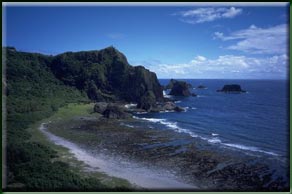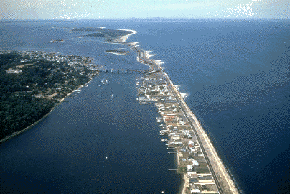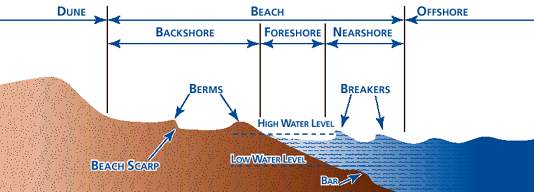
Types of Coasts
Types of Coasts and Beaches
The damage by storms, surges, and tsunamis depends in part of the type of coast.
There are many different types, and many different ways to classify coasts.
Geological Setting
The geological setting is important. The Office of Naval Research web page on coasts divided coasts into two categories:
- Primary Coasts, which were created by non-marine processes. The processes include erosion, deposition, and tectonic activity. River deltas are an important example
- Secondary Coasts, which were formed by marine action. The processes
include deposition of sand by waves and currents, and growth of
reefs by corals. Barrier islands are an important example.


Left: Image of a rocky coast (From US Office of Naval Research). Right: A barrier island (From J Butler)
How would you classify the Texas coast?
Tectonic Setting
The tectonic setting influences the geology of the coast. Inman and Nordstrom (1971) classify coasts based on plate tectonics. They recognize
- Collisional Coasts, such as the Pacific Coast of North America, characterized by steep, fault-guided cliff lines fronted by narrow continental shelves, and
- Trailing-edge Coasts, such as the east coast of the US, characterized by flat topography, lagoons, and wide continental shelves.
Coastal Landforms
The Wikipedia has a page that illustrates various types of coastal landforms. The Texas coast has:
- Barrier Islands "Elongate, narrow accumulations of sediment which have formed in the shallow coastal zone and are separated from the mainland by some combination of coastal bays and marshes. They are typically several times longer than their width and are interrupted by tidal inlets." From Barrier Island.
- Lagoons "A lagoon is a body of comparatively shallow salt or brackish water separated from the deeper sea by a shallow or exposed sandbank, coral reef, or similar feature." From Lagoon.
- River Deltas A feature at the mouth of a river caused by deposition of sediment. In Texas, the dominant delta is made by the Brazos River. On the Gulf Coast, the biggest delta is made by the Mississippi River.
Beaches
The beach type along the coast is also important.
A beach is a section of the seashore where unconsolidated sediment, or grains of worn-down rock, has collected. Unconsolidated sediment is a sediment in which the individual grains are clearly separated and can move freely, like grains of rice. In contrast, consolidated sediment is a sediment in which the individual grains cling together, like particles of moist flour or mud. Most beaches are composed primarily of sand (grains of quartz and other hard minerals between 0.063 mm/0.025 in. and 2 mm/0.08 in. in size), although some are composed primarily of pebbles or fragments of seashells. The unconsolidated and small sediments that make up a beach are easily moved by the action of waves and wind. Consequently, the shape of a beach is constantly changing as sand is removed from or deposited along the shoreline.
From Beaches by the Countryside Trust.Some geologists consider a beach to be merely a shoreline feature of deposited material, but Willard Bascom (1980) has argued that a beach is the entire system of sand set in motion by waves to a depth of ten meters (30+ feet) or more off ocean coasts. Submerged, longshore bars are therefore also part of the beach.
From Wikipedia: Beaches.The beach extends from the seaward limit of wave influence to the landward limit of wave influence. See Dr. Beach.
Beaches are dynamic landforms altered by wind and waves in a continual process of creation and erosion. Seasonal cycles of sand deposition and loss dramatically affect the appearance of beaches from summer to winter. Wide and gently sloping in summer, they become steep-fronted and narrow in winter, and can vanish overnight, stripped of sand by violent storm waves. Most of the sand removed from winter beaches is deposited in offshore sandbars and is returned to the beach during the mild summer months by gentle swells that push the sand to the exposed shore. River sediments are the source of 80 to 90 per cent of beach sand; some beaches are built to great widths by sediments washed to the sea by episodic floods, gradually eroding until the next major flood replenishes the sand.
From California Coastal Resources Guide.
Important features of a beach. From Dr Beach.
Another Classification
Fairbridge (2004 uses three processes to classify coasts:
The simplest description of a given coast requires a minimum of three terms, embracing the following: (1) material (hard/soft; soluble or otherwise); (2) agencies (erosive/constructive; physical, chemical, biological, and geographic setting [latitude, exposure, fetch]), and (3) historical factors (time scale: geotectonic, glacioisostatic, eustatic, steric, anthropic)..."
Classifications based on perceived "relative" relationships such as submergence or emergence are useful as generalizations, but only when provided with the time scale. Similar constraints apply to subsidence and uplift, and always subject to the three fundamental criteria.
From Fairbridge (2004).
References
Inman, D.L., and Nordstrom, C.E., l97l. On the tectonic and morpho- logic classification of coasts. Journal of Geology, 79: 1–21.
Revised on: 29 May, 2017

